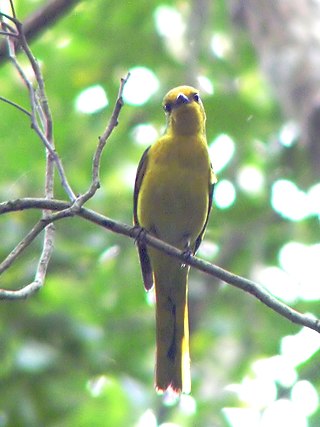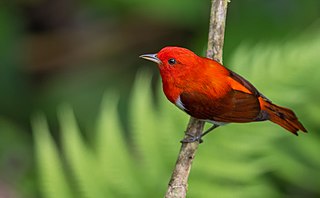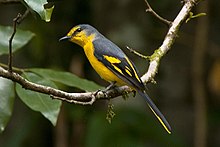
The minivets are passerine birds belonging to the genus Pericrocotus in the cuckooshrike family Campephagidae. There are about 15 species, occurring mainly in forests in southern and eastern Asia. They are fairly small, slender birds with long tails and an erect posture. Many species have bright red or yellow markings. They feed mainly on insects, foraging in groups in the tree canopy.

The scarlet minivet is a small passerine bird. This minivet is found in tropical southern Asia from Northeast India to southern China, Indonesia, and the Philippines. They are common resident breeding birds in forests and other well-wooded habitats including gardens, especially in hilly country. While the male of most subspecies are scarlet to orange with black upper parts, the females are usually yellow with greyish olive upper parts. Several former subspecies have been elevated to a species status in recent works. These include the orange minivet. All subspecies have the same habits of gleaning for insects and are often seen in mixed-species foraging flocks, usually foraging in small groups, high up in the forest canopy.

The small minivet is a small passerine bird. This minivet is found in tropical southern Asia from the Indian subcontinent east to Indonesia.

The white-bellied minivet is a species of minivet found in India, mostly in dry deciduous forest.

The yellow-faced myna is a species of starling in the family Sturnidae. It is found in New Guinea and nearby smaller islands, where its natural habitat is subtropical or tropical moist lowland forests. The long-tailed myna was formerly included as a subspecies. One of the largest species of starling, this species attains 23 to 26 cm in length and weighs around 217 g (7.7 oz). They have dark plumage with a metallic lustre and bright orange facial markings and beak. These birds are social and omnivorous. Their diet consists of fruit and insects for which they forage high in the canopy. They are common birds with a wide range, and the International Union for Conservation of Nature has assessed their conservation status as being of "least concern". It was named after Charles Dumont.

The scarlet-breasted fruit dove is a species of bird in the family Columbidae. It is endemic to Indonesia, where it occurs in the northern Moluccas. Its natural habitat is subtropical or tropical moist lowland forests. It is rated as a species of least concern on the International Union for Conservation of Nature Red List of Endangered Species. In 1863 Hermann Schlegel named the new species for one of his collectors, Heinrich Agathon Bernstein.

The scarlet-and-white tanager is a species of bird in the family Thraupidae. It is found in Colombia and northern Ecuador. Its natural habitats are subtropical or tropical moist lowland forests and heavily degraded former forest. The male is highly distinctive and has bright scarlet upperparts, darker red wings and undertail coverts, and white underparts with a scarlet median stripe running down the throat and belly. Females are patterned like the males, but are olive-brown instead of scarlet.

The ashy minivet is a passerine bird of eastern Asia belonging to the minivet genus Pericrocotus in the cuckooshrike family Campephagidae. While most of the minivets have shades of yellow, orange and red in their plumage, this species has only greys, whites and blacks. The male is distinctive with a white face and black nape although females can be confused with the female of the brown-rumped minivet. They forage in the canopy, often along with other minivets and join mixed-species foraging flocks.

The long-tailed minivet is a species of bird in the family Campephagidae. It is found in southern and south-eastern Asia where it occurs in Afghanistan, Bangladesh, Bhutan, China, India, Laos, Myanmar, Nepal, Pakistan, Thailand, and Vietnam. Its natural habitats are subtropical or tropical moist lowland forest and subtropical or tropical moist montane forest.

The fiery minivet is a species of bird in the family Campephagidae. Its range includes Thailand, Malaysia, Indonesia and the Philippines. Its natural habitats are broadleaf, secondary and coastal forests. It is threatened by forest clearance and has been assessed as near-threatened by the International Union for Conservation of Nature (IUCN).

The rosy minivet is a species of bird in the family Campephagidae. It is omnivorous.

The grey-chinned minivet is a species of bird in the family Campephagidae. It is found from the Himalayas to China, Taiwan and Southeast Asia. Its natural habitat is forests about 1,000–2,000 m (3,300–6,600 ft) in elevation. The International Union for Conservation of Nature (IUCN) has assessed it as a least-concern species.

Layard's palm squirrel or flame-striped jungle squirrel is a species of rodent in the family Sciuridae endemic to Sri Lanka. The validity of the subspecies F. l. dravidianus based on a single specimen from the southern tip of India has been questioned, and is probably a juvenile F. sublineatus. Known as මූකලන් ලේනා in Sinhala.















